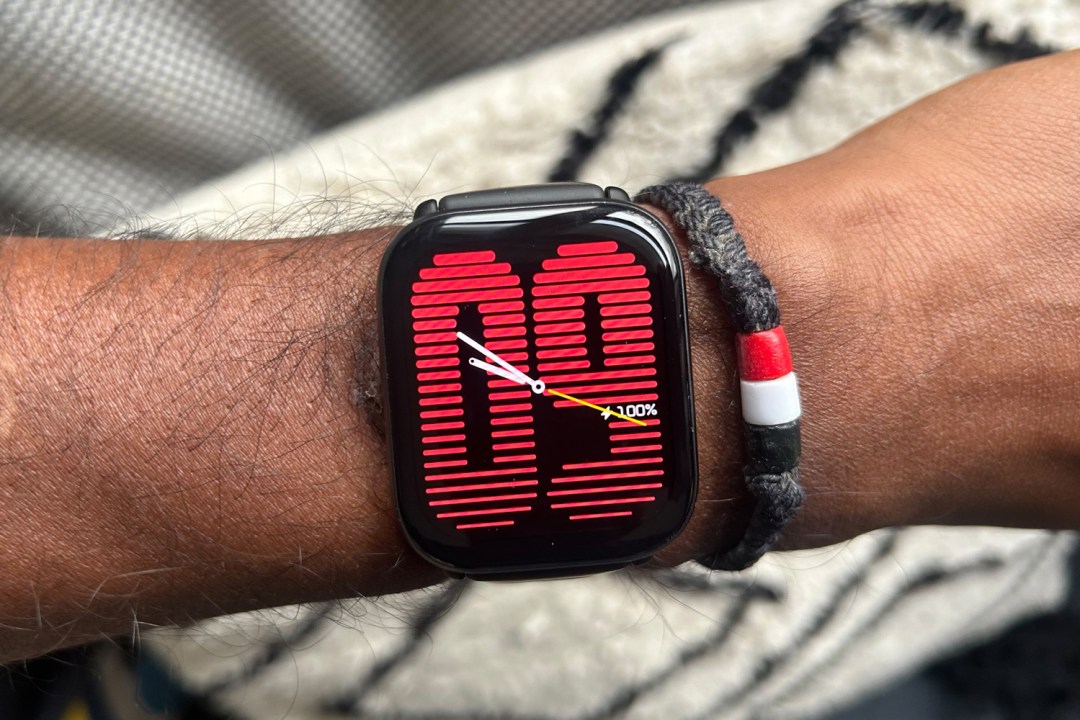Amazfit Active review: fully featured on fitness
Activate your active side on the cheap

Stuff Verdict
A cut-price smartwatch that piles in the features and offers a good performance to match, the Amazfit Active runs the risk of being too well equipped for the cash.
Pros
- Nicely presented Readiness feature
- Good collection of smartwatch features
- Smooth-running software
Cons
- OS looks a bit childish
- GPS accuracy not great
- Maybe too many features?
Introduction
If you don’t have the funds to splash out on an Apple Watch or Google’s Pixel Watch but you want that smartwatch feeling, then Amazfit is here to fill that available spot on your wrist. The Amazfit Active emerges as another affordable member of the Chinese brand’s big family, offering an iOS and Android-friendly option that offers a mix of health, fitness and smartwatch features and strives to make sure you’re better suited to take on your day.
The Active is squaring off against smartwatches like the Fitbit Versa 4, which officially retails for considerably more, but can be picked up for a similar amount if you shop around. It’s a similar story for Garmin’s Venu SQ 2. Does the Amazfit Active stand out against such capable competition? And does it live up to that Active name?
How we test wearables
Every smartwatch and fitness tracker reviewed on Stuff is worn 24/7 throughout the testing process. We use our own years of experience to judge general performance, battery life, display, and health monitoring. Manufacturers have no visibility on reviews before they appear online, and we never accept payment to feature products.
Find out more about how we test and rate products.
Design & build:



There’s nothing particularly new or eye-grabbing about what the Amazfit Active is bringing to the smartwatch design table. It’s your pretty standard square affair with gently curved case corners. That isn’t going to get it mistaken for an Apple Watch, but it doesn’t feel too blocky or drab.
It’s light at just 24g, helped by a mainly aluminium frame that prevents this affordable watch from feeling too budget. At 42mm it’s only slightly bigger than the 41mm version of the Apple Watch Series 9.
There are three colour versions to pick from. I had the more low-key midnight black version. There’s also a petal pink and lavender pink Active, with the latter swapping aluminium for stainless steel. That slightly nudges the weight up (to 27g), but you’re still getting a relatively lightweight watch whichever option you go for.
There’s just the one physical button, which flanks the touchscreen display. A 20mm removable strap kept that case securely on my wrist. It’s a silicone strap with the black version, but the lavender pink model gets some extra styling cred with a vegan leather one.
A 5ATM waterproof rating means it’s safe to keep on when you jump in the shower, and it can join you for a swim as long as you don’t go deeper than 50 metres. That likely won’t be a scenario for most. The small case stature also means it doesn’t feel at all cumbersome to wear when tracking lengths in the water.
Amazfit sticks to what has become its pretty universal charging cable to plug into the case back, but doesn’t clamp tight to that case. l always double checked to make sure it was securely in place whenever I put it on charge.
Screen:


Packed into that 42mm case body is a 1.75in, 390×450 resolution AMOLED touchscreen. The dreaded black bezel eats into some of that space, though the predominantly black watch faces do the trick of disguising it. Annoyingly, you’re only able to store two faces at a time on the watch, which means diving back into the Zepp app when you want to mix things up.
You do have the option to keep that screen always-on; a smart mode then keeps it off when you don’t need it (like in bed). Opt for the nicely responsive raise to wake gesture instead and you’ll get noticeably more battery in return.
This is a good quality screen to find on such a budget-minded smartwatch. It’s sharp, colours are accurate and not overly saturated as can be the case on some AMOLED panels. Screen visibility has been absolutely fine indoors and outdoors. While the tempered glass isn’t the best protection against screen scrapes you’ll find, I haven’t had any unwelcome scratches appear on it either.
Interface:




Amazfit’s own ZeppOS 2.0 operating system plays nice with Android smartphones and iPhones. I’ve had a pretty stress-free experience using it with the latter setting things up and syncing up daily stats. Using the Active with Apple’s smartphone does mean you miss out on some smartwatch features – but you also gain some. You lose the ability to quickly reply to messages, but gain the ability to use the Active to remotely take pictures from your wrist.
Outside of that, this is a smartwatch that will display your notifications from native and third party apps. You’ll just need to tap to expand notifications to fully read them. You can make calls via Bluetooth, and while you can only store a couple of watch faces on the watch, there are hundreds to pick from. You can also make your own from your own images if that’s your bag.
Amazfit surprisingly does include music storage along with playback controls, but you’ve got a minuscule 250 MB to play with. Ticking the smart assistant box is Amazon Alexa, so you have somewhere to fire your queries about the weather, good restaurants nearby or to get Alexa to tell you a joke. There’s no payment support, though. And while you do have access to an app store, we’re not talking Apple App Store or Google Play Store-levels of familiar or big name apps.
While Zepp OS is an operating system that feels easy to get to grips with and offers some well-performing smartwatch features, I can’t help feeling that visually it feels a little childish in comparison to Google’s Wear OS or Apple’s watchOS.
Health & fitness:



As is generally the case with Amazfit watches, the Active throws a lot of health tracking features at you. Some work fine, some feel less useful, and collectively they could all do with being a bit more connected to each other.
An accelerometer enables indoor workout tracking and sleep monitoring. There’s a biometric sensor to track your heart rate, blood oxygen and temperature. Built-in GPS makes it more useful for tracking your outdoor exercise time.
There are also some AI-powered features here. Zepp Fitness is essentially an AI chatbot you can ask for training and nutrition advice. It requires a subscription, with a free trial offered up to see if it’s something you’ll find useful. I didn’t feel the need to hand over my credit card details. Zepp Coach, meanwhile, can build training plans and offer ideal sessions in that training plan. Think Amazfit’s take on ChatGPT, although it still needs work in its current guise to be anything close to really useful.
GPS performance isn’t super accurate, and the heart rate tracking falters against a heart rate monitor chest strap for both average heart rate and maximum heart rate readings. That puts a big question mark over Amazfit’s PeakBeats training insights, many of which are fuelled by that heart rate and general sports tracking performance.
Granted, there are a lot of sports modes and profiles, along with the ability to create training plans, import routes and enjoy breadcrumb navigation on the watch. It also offers some (far from groundbreaking) predicted running time calculations. Sometimes less is more and that’s something Amazfit should think about here.
The Active is more fitting as a fitness tracker, where resting heart rate data felt more reliable, core sleep tracking stats were in line with Oura and Garmin sleep data, and daily step counts were generally in line too. There were are few days step counts were 2,000 steps off Garmin and Oura’s daily totals, though.
Readiness is the big new all-day tracking feature. It sees Amazfit essentially do a version of a feature you’ll find on Fitbit and Garmin watches and wearables like the Oura Ring and Whoop Strap. It scores you out of 100 based on resting heart rate, heart rate variability and breathing quality during your sleep. You basically want that score to be in the green. I’ve been using it alongside Garmin’s similar training readiness feature and the two watches largely scored me the same for readiness.
The Readiness metric is nicely presented on the watch as well and feels like a standout feature here for Amazfit. It’s a shame that the additional insights are also locked behind another subscription aspect on the Zepp companion app however.
Battery life:


The Amazfit Active’s longevity entirely depends on what you decide to track on a daily basis. A 300mAh capacity battery promises to get you up to 14 days battery life in typical usage or 10 days in heavier usage. There’s a 30-day strong battery saver mode, which restricts the features on offer, while you can also enjoy 16 hours of GPS tracking battery life.
If you choose to keep that screen always on, and don’t use the smart mode that will switch off that screen at times you’re not staring at the screen, that battery will drop in a big way. Over a day, with mainly activity tracking in use, receiving notifications and some of the continuous health monitoring features enabled, the battery dropped by 10% – as opposed to half that on days when not using the screen in always-on mode. The battery drop overnight is also more severe and means you’re getting a handful of days use and nowhere near that 14 days.
If you can live with just using the raise to wake mode and you’re not using power intensive features like GPS or have all of the health tracking features turned on, this watch is absolutely capable of going for a week and potentially longer. Realistically, it’s getting you roughly a week, which is no bad thing.
Amazfit Active verdict

The Amazfit Active emerges as a smartwatch that’s definitely aiming itself at smartwatches like the Fitbit Versa and Garmin’s Venu Sq series. This isn’t a watch competing with Apple, Google or Samsung.
If you keep that in mind, the Active offers a tidy package of features, a nicely made design and good performance in places. The software still needs to mature and definitely lacks some of the polish you get from similarly priced square smartwatches. I do think it tries to do much and would benefit from reigning things in and nailing some of the core features first.
I’ve mostly enjoyed having the Active on and with some uncertainty around the future of Fitbit’s Versa series, there’s a space for someone to grab that mid-range smartwatch spot. I just think that the Venu Sq 2 will get you more fully formed software and smartwatch features and more reliable sports tracking in comparison.
This is another solid Amazfit smartwatch that feels more fitness tracker than an all-seeing, all-conquering affordable smartwatch.
Stuff Says…
A cut-price smartwatch that piles in the features and offers a good performance to match
Pros
Nicely presented Readiness feature
Good collection of smartwatch features
Smooth-running software
Cons
OS looks a bit childish
GPS accuracy not great
Maybe too many features?
Amazfit Active technical specifications
| Screen | 1.75in, 450×390 AMOLED |
| CPU | Proprietary dual-core |
| Memory | Not stated |
| Storage | 250MB |
| Connectivity | Bluetooth 5.2, GPS |
| Durability | 5ATM |
| Operating system | Zepp OS 2.0 |
| Battery | 300mAh |
| Dimensions | 42x36x10.8mm, 24g |
